Bear-dog Hybrids
Mammalian Hybrids
|
A diligent scholar is like a bee who takes honey from many different flowers and stores it in his hive.
—John Amos Comenius
|
This cross, which is interfamilial (Canidae × Ursidae), is listed in various older works. However, the disparity of the cross and the old and unreliable nature of most of the documenting sources raise many questions.
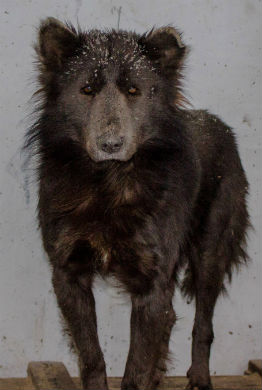 Enlarge
Enlarge
Russian bear-dog
There is, however, a recent (2018) case of an ostensible bear-dog for which photographic evidence has become available (see slide show above and enlargeable photo at right). This apparent bear-dog hybrid was brought to an animal shelter in the Russian city of Chelyabinsk. Its parentage is unknown, but it has obvious traits in common with a bear. Given the geographic location, the bear parent in question would be Ursus arctos, the Brown Bear. The photos shown here were released by the shelter.
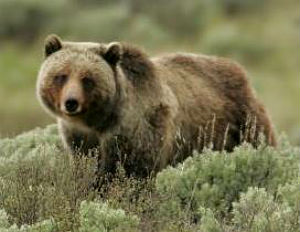
This cross rarely occurs or, at least, is rarely recorded. Indeed, it seems that all reports other than the recent one about the Chelyabinsk animal, are at least a century old. But then again, encounters between bears and dogs would no doubt have been far more common in former days when bears themselves were far more common and widespread.
One of the least antique of these early accounts is the following article, quoted here in its entirety from the American Veterinary Review (1905-6, vol. 29, p. 408). It seems to be the only scientific paper ever to report such a hybrid.
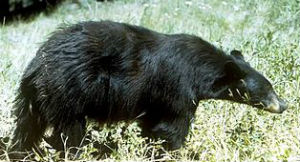 Black bear, Ursus americanus
Black bear, Ursus americanus
Another report dating to the early part of the twentieth century appeared in the Yakima, Washington, Herald (Jan. 11, 1911, p. 8, col. 4):
COL. ASTOR TO BRING FREAK DOG
Asked to Bring “Bear-Dog” to Celebration of Founding of City—Will Participate in Centennial Which is Being Planned.
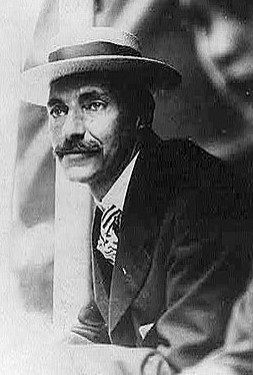 John Jacob Astor IV
John Jacob Astor IV1864-1912
Col. Astor, according to reports which have excited the Astorians, has an animal that is plainly half dog and half bear. He bought it from gypsies in the Pyrenees Mountains. He says it walks with a “waddling gait,” and is wholly unknown to the common or garden variety of scientists that infest New York.
Looks Like a Bear
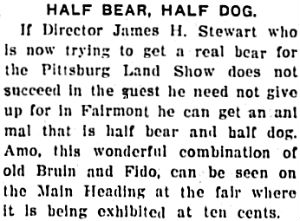 A 1911 news notice about a bear-dog. Possibly the same animal owned by Astor? (source: The Fairmont West Virginian, Sep. 13, 1911, p. 8, col. 3).
A 1911 news notice about a bear-dog. Possibly the same animal owned by Astor? (source: The Fairmont West Virginian, Sep. 13, 1911, p. 8, col. 3).
Col. Astor is expected to represent his illustrious ancestor of the same name at the Astoria Centennial and will probably be made honorary chairman of the affair. People of the coast hope to have a look at the “bear-dog.”
One of the richest men in America, Astor died the following year in the sinking of the Titanic.
A report twenty years older than that just quoted, appeared in the Waterbury, Connecticut, Evening Democrat (Mar. 26, 1892, p. 2, col. 4):
A REMARKABLE HYBRID
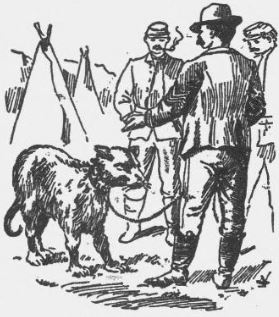 Illustration from the original article.
Illustration from the original article.
One afternoon several of the officers of the Nineteenth Kansas were sauntering through the Arapahoe encampment, when they were somewhat startled by coming upon a ferocious looking brute tied behind one of the Indian wickies. it was about the size of a year old Newfoundland dog and of a greyish brown color. The head and neck presented a wild and formidable appearance, somewhat resembling a mountain lion, while the body and limbs were long and lank and decidedly wolfish ins shape and looks. While critically examining it from a safe distance an old squaw came out and thorough a half-breed interpreter, with the party, the gentleman learned that its singular pedigree. A female Indian dog had crossed with a coyote, the offspring being female, and this hybrid had again crossed with a cinnamon bear [see discussion of cinnamon bears below], the result being the animal before them. Capt. David Payne of the Nineteenth was seized with a desire to possess the brute and found little difficulty in persuading the squaw to exchange it for a moderate quantity of coffee and sugar. Being taken to camp it became the general of curiosity, and many an evening game of poker was played for its possession, everyone being anxious to bring it back to the states and open negotiations with Barnum for a fancy price.
It required but little experience with the brute to demonstrate the fact that it entirely belied its looks, and was really one of the most timorous and cowardly of animals. Pointing a finger at it would make the cur slink behind the tent in abject fear, while it would run away from the smallest dog in camp. It had simply inherited all the bad qualities of its mixed ancestry and none of the good ones.
About the middle of February its owner got a leave of absence to return to Kansas in company with Col. Crawford of the Nineteenth, who had resigned his commission, and the attempt was made do bring the brute into the purviews of civilization. As the trip of some 550 miles had to be made with pack-mules, it was necessary to lead the dog and he was placed in charge of the captain's orderly. In crossing the broad prairies between Fort Arbuckle and Fort Gibson, the animals feet became so sore and inflamed from cactus thorns that mortification took place and he had to be killed. Even the skin could not be saved and thus this remarkable hybrid was entirely lost to science.
There are few records of hybrids breeding in the second generation, but this case was well authenticated, and the brute is well remembered by the men of the Nineteenth Kansas, and many of the officers of the Seventh United States cavalry who survive the Big Horn Massacre.
The Arapaho are a tribe of Native Americans historically living on the plains of Colorado and Wyoming.
The Cinnamon Bear is usually treated as a subspecies (cinnamomum) of the Black Bear (Ursus americanus). However, since cinnamomum occurs in regions where U. americanus and the Brown Bear (U. arctos) overlap, and since it resembles the latter in coat color while being classified as a subspecies of the former, the possibility should be considered that it may be derived from hybridization between U. americanus and U. arctos, especially given that it is known that such hybrids have occurred both in the wild and in captivity.
Another report about a cinnamon bear crossing with a dog appeared in the Pueblo, Colorado, Chieftain (Apr. 1, 1886, p. 6, col. 2):
A Marvelous Freak or Nature
From the Petaluma, California, Courier (Nov. 14, 1883, p. 3, col. 4):
Half Bear and Half Dog
A passage excerpted from a description of an upcoming dog show (San Francisco, California, Chronicle, Apr. 27, 1883, p. 3, col. 7; ||y2nfjfdq):
A news notice about the demise of a bear-dog hybrid (The San Francisco Call, Jul. 19, 1902, p. 14; ||yxwklfqz):
Freak Animal Is Killed
And yet another report about a bear-dog in California (Santa Cruz, California, Evening Sentinel, Jun. 22, 1899, p. 3, col. 2; ||y6rx95gz).
 A report about a bear-dog belonging to the Welsh Brothers Circus (Pottsville, Pennsylvania, Republican, May 28, 1897, p. 1, col. 7; ||y2efzt2y).
A report about a bear-dog belonging to the Welsh Brothers Circus (Pottsville, Pennsylvania, Republican, May 28, 1897, p. 1, col. 7; ||y2efzt2y).
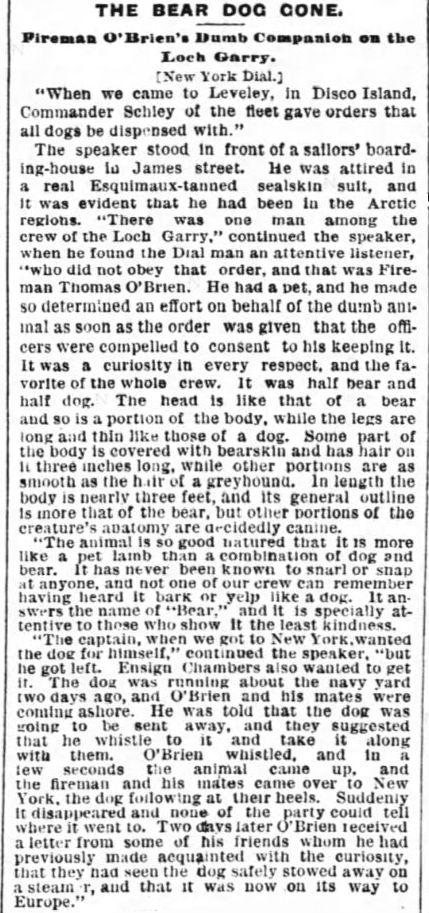 A story about a kidnapped bear-dog (Boston, Massachusetts, Globe, Aug. 24, 1884, p. 13, col. 6; ||y4zjk8ln).
A story about a kidnapped bear-dog (Boston, Massachusetts, Globe, Aug. 24, 1884, p. 13, col. 6; ||y4zjk8ln).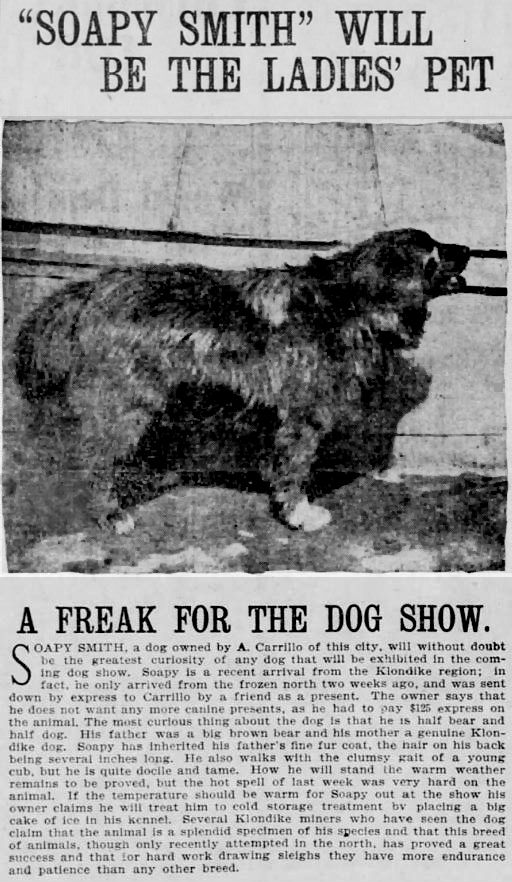 A story about a grizzly bear/dog hybrid brought to San Francisco from the Klondike for an 1899 dog show (San Francisco, California, Call, Apr. 26, 1899, p. 13; ||y6m4qarz).
A story about a grizzly bear/dog hybrid brought to San Francisco from the Klondike for an 1899 dog show (San Francisco, California, Call, Apr. 26, 1899, p. 13; ||y6m4qarz).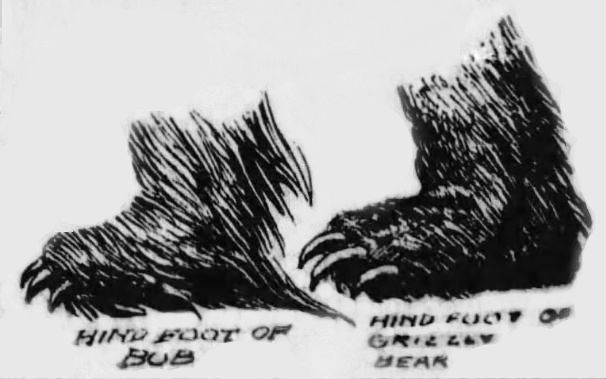 Hindfoot of an alleged bear-dog named "Bob" (left) compared to that of a grizzly (San Francisco, California, Examiner, Oct. 14, 1901, p. 1; ||y5phj9lh).
Hindfoot of an alleged bear-dog named "Bob" (left) compared to that of a grizzly (San Francisco, California, Examiner, Oct. 14, 1901, p. 1; ||y5phj9lh).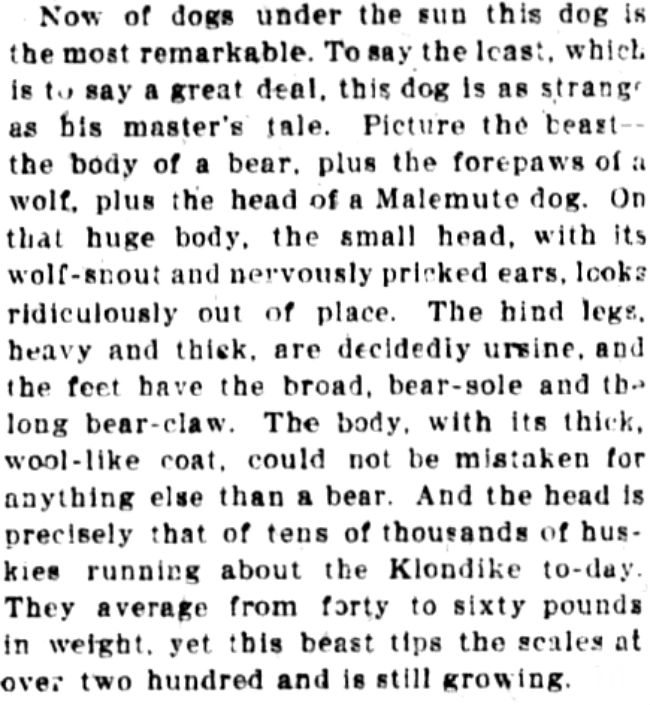 A description of the alleged bear-dog named "Bob" whose hindfoot is compared to that of a grizzly in the picture above (San Francisco, California, Examiner, Oct. 14, 1901, p. 1; ||y5phj9lh).
A description of the alleged bear-dog named "Bob" whose hindfoot is compared to that of a grizzly in the picture above (San Francisco, California, Examiner, Oct. 14, 1901, p. 1; ||y5phj9lh).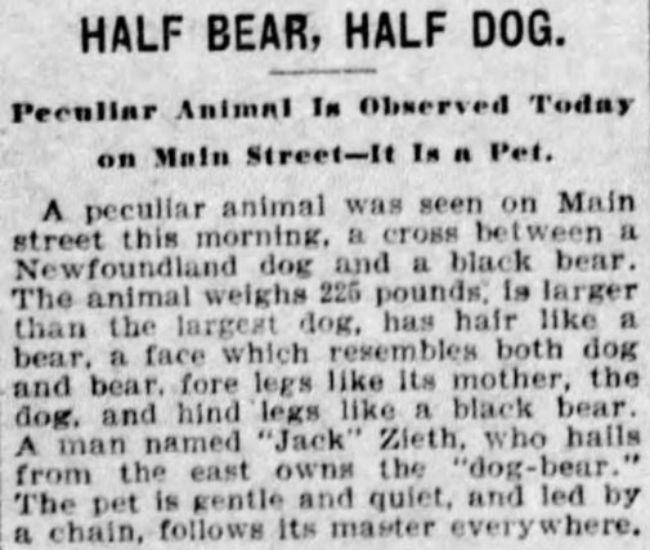 Report about a bear-dog weighing more than 200 pounds (Oshkosh, Wisconsin, Northwestern, Nov. 7, 1901, p. 3, col. 3; ||yynqls77).
Report about a bear-dog weighing more than 200 pounds (Oshkosh, Wisconsin, Northwestern, Nov. 7, 1901, p. 3, col. 3; ||yynqls77). Report about a bear-dog being given to the Salt Lake City Zoo (Salt Lake City, Tribune, May. 16, 1932, p. 16, col. 3; ||yynqls77). Peoa is an unincorporated census-designated place in southwestern Summit County, Utah, between Jordanelle and Rockport state parks.
Report about a bear-dog being given to the Salt Lake City Zoo (Salt Lake City, Tribune, May. 16, 1932, p. 16, col. 3; ||yynqls77). Peoa is an unincorporated census-designated place in southwestern Summit County, Utah, between Jordanelle and Rockport state parks.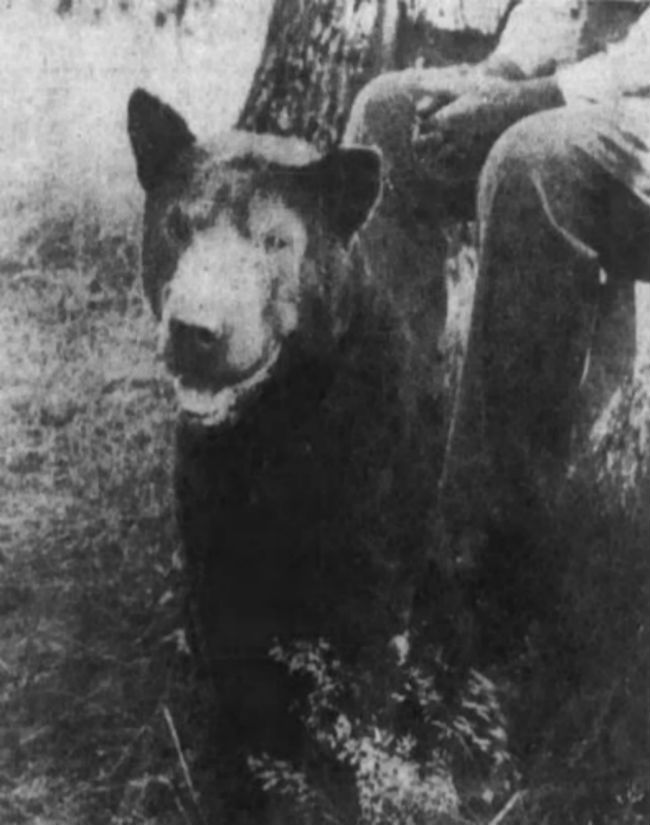 Above: Picture that accompanied the story shown below, about a bear-dog hybrid in Herbertsville, New Jersey (Long Branch, New Jersey, Daily Record, Sep. 11, 1943, p. 1; ||yyxd23r3). Herbertsville is an unincorporated community located within Brick Township in Ocean County, New Jersey.
Above: Picture that accompanied the story shown below, about a bear-dog hybrid in Herbertsville, New Jersey (Long Branch, New Jersey, Daily Record, Sep. 11, 1943, p. 1; ||yyxd23r3). Herbertsville is an unincorporated community located within Brick Township in Ocean County, New Jersey.
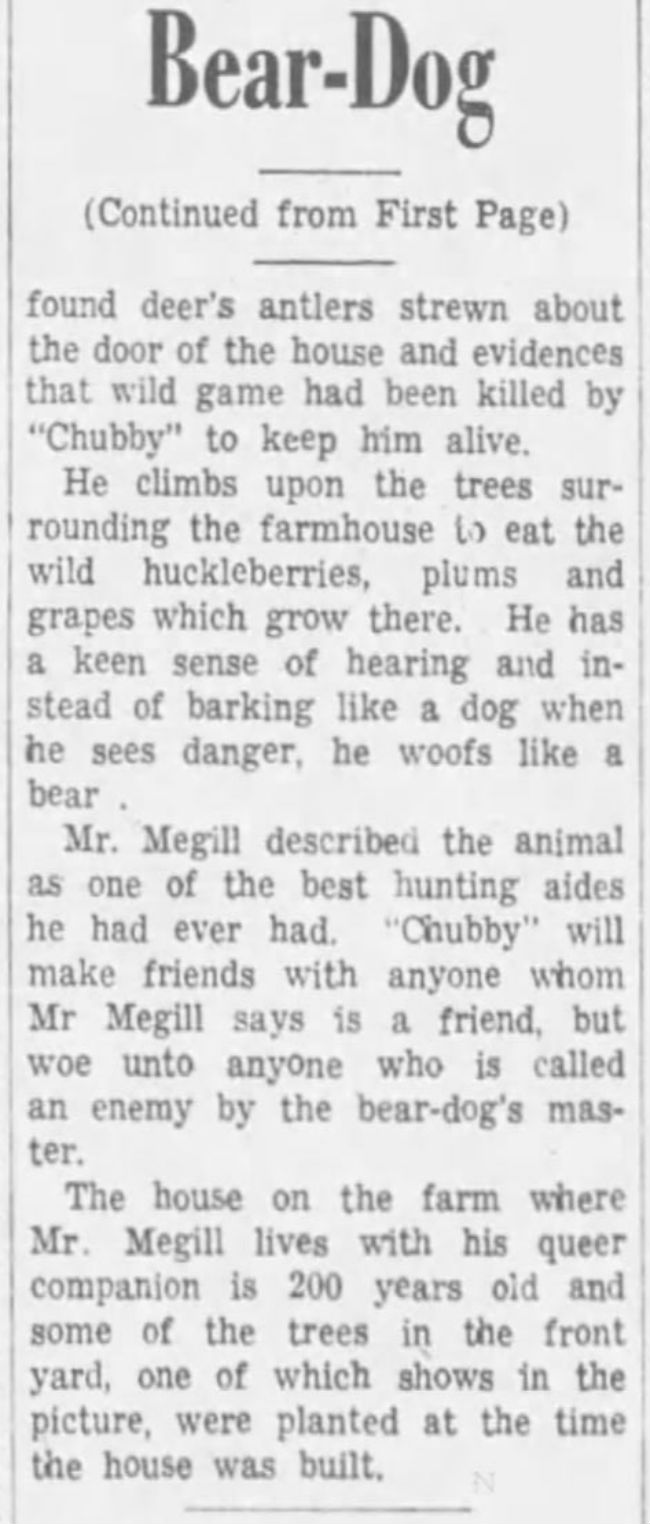 Above: News report about a bear-dog hybrid (see picture above) birthed by a chow dog bitch who had mated with a bear, presumably a black bear, given the locale (Long Branch, New Jersey, Daily Record, Sep. 11, 1943, p. 1; ||yyxd23r3). Herbertsville is an unincorporated community located within Brick Township in Ocean County, New Jersey.
Above: News report about a bear-dog hybrid (see picture above) birthed by a chow dog bitch who had mated with a bear, presumably a black bear, given the locale (Long Branch, New Jersey, Daily Record, Sep. 11, 1943, p. 1; ||yyxd23r3). Herbertsville is an unincorporated community located within Brick Township in Ocean County, New Jersey.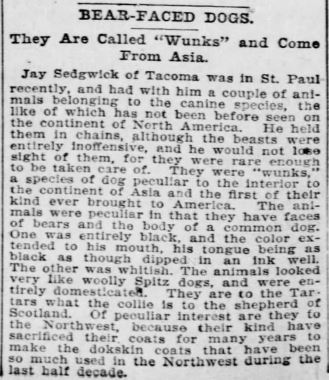 Above: A report about two ostensible bear-dog hybrids (St. Louis Post-Dispatch Apr. 19, 1896, p. 33; ||y5b4aa63).
Above: A report about two ostensible bear-dog hybrids (St. Louis Post-Dispatch Apr. 19, 1896, p. 33; ||y5b4aa63).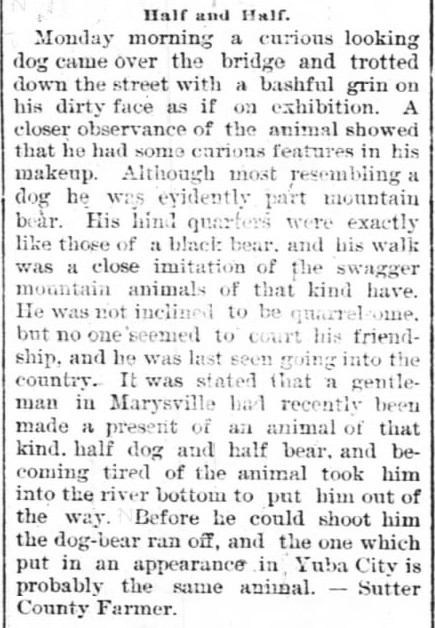 Above: A report in the Wilmington, North Carolina Messenger, Oct. 15, 1890, p. 2; ||y2nosx5z).
Above: A report in the Wilmington, North Carolina Messenger, Oct. 15, 1890, p. 2; ||y2nosx5z). Above: A report about a chicken-rustling bear-dog (Philadelphia Inquirer, Mar. 19, 1896, p. 4; ||yxsfr5l4).
Above: A report about a chicken-rustling bear-dog (Philadelphia Inquirer, Mar. 19, 1896, p. 4; ||yxsfr5l4).
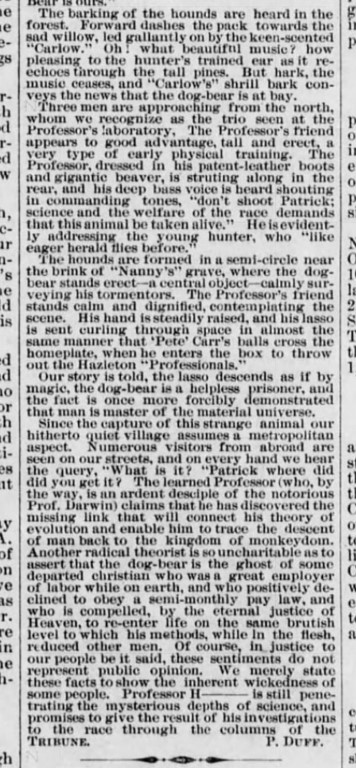 Above: A report about the capture of a bear-dog (Freeland Tribune, Freeland, Pennsylvania, Apr. 3, 1890, p. 1).
Above: A report about the capture of a bear-dog (Freeland Tribune, Freeland, Pennsylvania, Apr. 3, 1890, p. 1).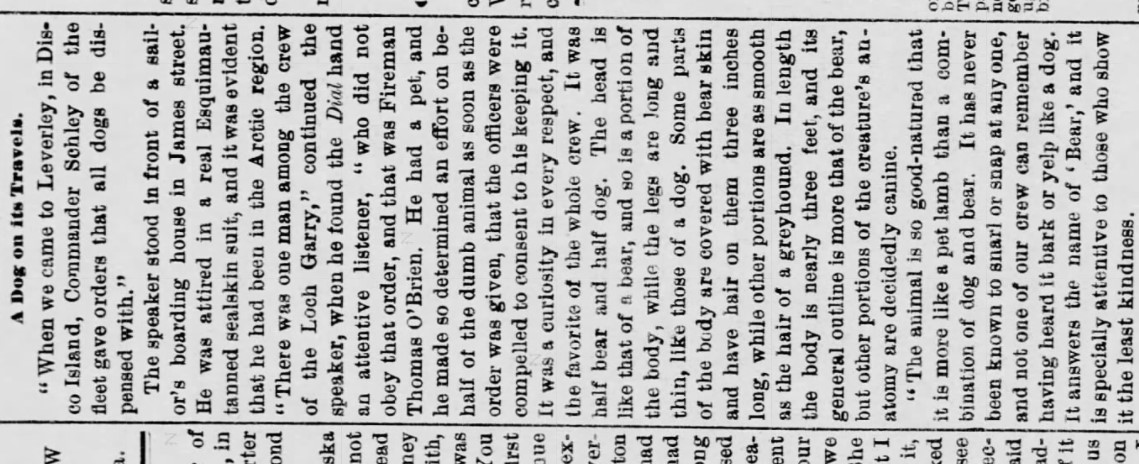
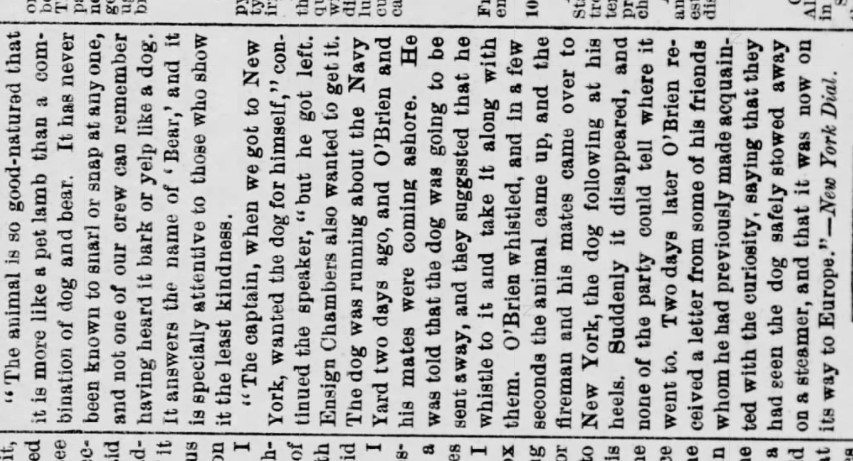 Above: A report about a traveling bear-dog (Topeka, Kansas, Weekly Times, Aug. 22, 1884, p. 1).
Above: A report about a traveling bear-dog (Topeka, Kansas, Weekly Times, Aug. 22, 1884, p. 1).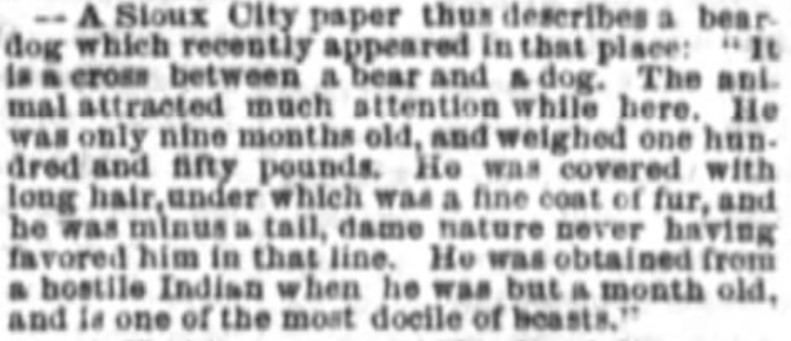 Above: A report about a bear-dog in Sioux City (National Republican, Washington, D. C., Jan. 2, 1872, p. 1).
Above: A report about a bear-dog in Sioux City (National Republican, Washington, D. C., Jan. 2, 1872, p. 1).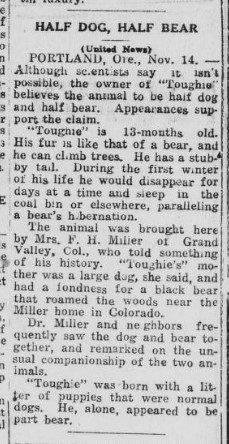 Above: A report about a bear-dog in Portland (Nogales International, Nogales, Ariz., Nov. 15, 1925, p. 6; ||5rw5r2vr).
Above: A report about a bear-dog in Portland (Nogales International, Nogales, Ariz., Nov. 15, 1925, p. 6; ||5rw5r2vr).Bear-dog Hybrids: Early reports
Older reports of bear-dog hybrids exist as well. Writing during the Elizabethan era, the French humanist Pierre Boaistuau, in his Histoires prodigieuses, says dogs and bears were intentionally mated in London and that sometimes a hybrid resulted.
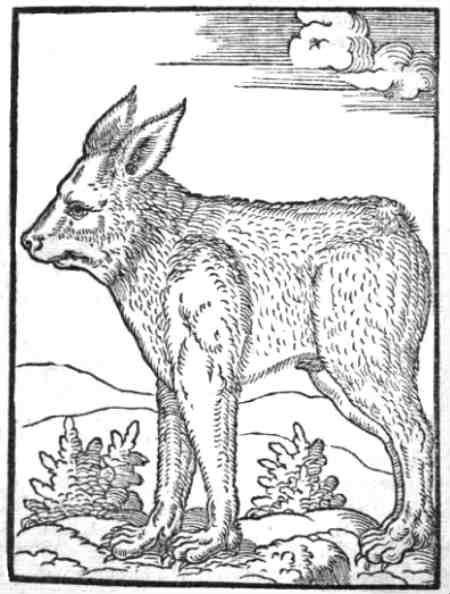 Woodcut illustration of an supposed bear-dog hybrid (Boaistuau 1591, p. 206).
Woodcut illustration of an supposed bear-dog hybrid (Boaistuau 1591, p. 206).
He includes an illustration (above) of what he says was a bear-dog hybrid born of a bitch mated with a bear (“La mere qui la porta estoit chiene, & le masle qui la couvrit estait ours.”). Bears and dogs, usually mastiffs, were kept to fight in the bear baitings so popular at the time. An English translation of the passage in question (Boaistuau 1591, pp. 133-135) reads as follows:
Boaistuau then turns to a discussion of other types of hybrids, but eventually returns to his description of the bear-dog:
The exact identity of the bears involved in Elizabethan bear baitings is somewhat in doubt. But it seems that the Brown Bear (Ursus arctos) is the animal in question. No bears of any other kind were present in Europe. As Henry Reeks (1878) states in a scholarly article on mammals mentioned by Shakespeare, the brown bear (he refers to Ursus arctos and to its synonym Ursus isabellinus) “would probably be the bear with which Shakespeare would be most familiar. Bear baiting seems to have been a very popular amusement about that period and for many years subsequently.”
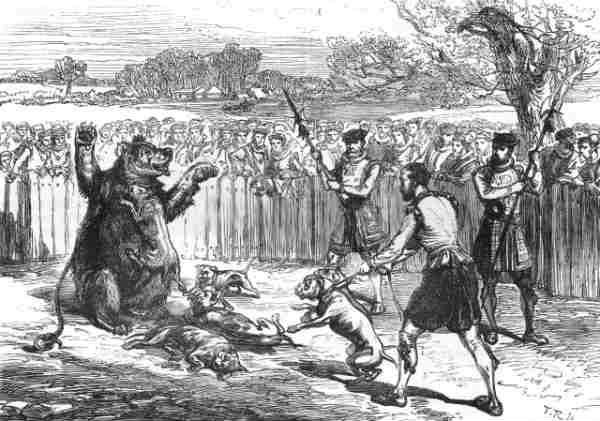 An Elizabethan bear baiting
An Elizabethan bear baiting
Though one might suppose that a brown bear would be far too large to mate with a dog, there is a very wide range of geographic variation in the adult size of these animals. Nowak (1999, pp. 685-686) states that while brown bears may weigh as much as 780 kg (1720 lbs) on the southern coast of Alaska, elsewhere they can be far smaller. For example, the average figure he gives for southern Europe is just 70 kg (154 lbs). It does seem, then, that some bears would be within the size range that would allow mating with a large dog, such as a mastiff.
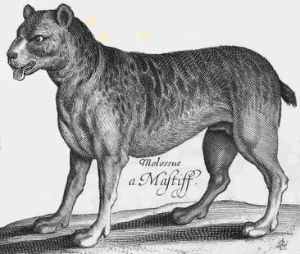 17th-century depiction of a mastiff.
17th-century depiction of a mastiff.
Another report about such a cross was given by Jakob Benjamin Fischer in his Naturgeschichte von Livland (1791, p. 146), where mentions a bear-dog hybrid that was supposedly fertile. He gives the cross in the same direction as in the account of the Denver hybrid and that by Boaistuau (female dog/male bear), but in the opposite direction from that specified above in the Pueblo Chieftain:
The gestation periods of dogs and bears differ widely (a little over two months in the former versus 7 months in the latter).
Chromosomes
The chromosome counts of dogs and bears are fairly similar (in dogs, 2n=78, in both black and brown bears, 2n=74).
Scherren (1907, pp. 432-433) provides a brief review of reports alleging the occurrence of this cross.
Nowadays, dogs and bears are rarely caged together, and there seem to be no reports about attempts to cross them. Therefore, it must remain an open question whether the various early reports about bear-dog hybrids have any basis in fact.
Fossils demonstrate the former existence of animals known as bear-dogs (Family Amphicyonidae, 46.2-1.8 mya) and dog-bears (Family Hemicyonidae, 33.9–5.3 mya). These creatures were so named because they had both bear- and dog-like traits. An example of the bear-dog Amphicyon, is shown above and an artist’s reconstruction of the dog-bear Hemicyon appears below.
By the same author: Handbook of Avian Hybrids of the World, Oxford University Press (2006).
|
An account of Elizabethan bull and bear baiting
“There is still another place, built in the form of a theatre, which serves for the baiting of bulls and bears they are fastened behind and then worried by great English bull-dogs but not without great risk to the dogs from the horns of the one and the teeth of the other; and it sometimes happens that they are killed upon the spot, fresh ones are immediately supplied in the places of those that are wounded or tired.” (from Travels in England During the Reign of Queen Elizabeth by Paul Hentzner and Sir Robert Naunton)
On bear baiting
(from Chambers 1864) “In the twelfth century, the baiting of bulls and bears was the favourite holiday pastime of Londoners; and although it was included in a proclamation of Edward III, among ‘dishonest, trivial, and useless games,’ the sport increased in popularity with all classes. Erasmus, who visited England in the reign of Henry VIII, speaks of ‘many herds’ of bears regularly trained for the arena; the rich nobles had their bearwards, and the royal establishment its ‘master of the king’s bears.’ For the better accommodation of the lovers of the rude amusement, the Paris Garden Theatre was erected at Bankside, the public being admitted at the charge of a penny at the gate, a penny at the entry of the scaffold, and a penny for quiet standing. When Queen Mary visited her sister during her confinement at Hatfield House, the royal ladies were entertained with a grand baiting of bulls and bears, with which they declared themselves ‘right well contented.’ Elizabeth took especial delight in seeing the courage of her English mastiffs pitted against the cunning of Ursa and the strength of Taurus. On the 25th of May 1559, the French ambassadors ‘were brought to court with music to dinner, and after a splendid dinner, were entertained with the baiting of bears and bulls with English dogs. The queen’s grace herself, and the ambassadors, stood in the gallery looking on the pastime till six at night.’ The diplomatists were so gratified that her majesty never failed to provide a similar show for any foreign visitors she wished to honour.” |
|
|
| The Paris Garden Theatre, Bankside, the primary venue for bear baitings in old London (engraving from Chambers 1864, vol. II, p. 57) |
Bear-dog Hybrids - © Macroevolution.net
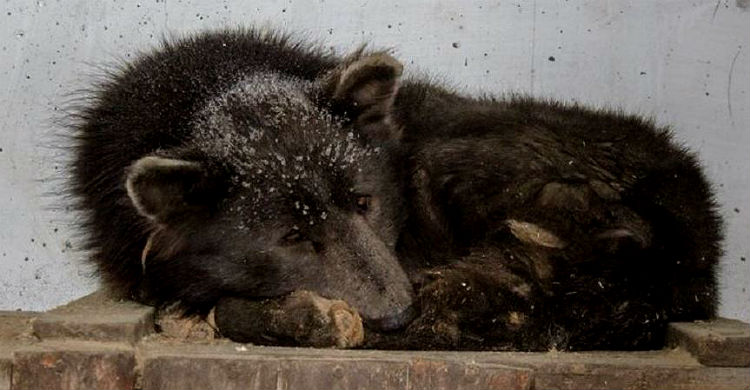
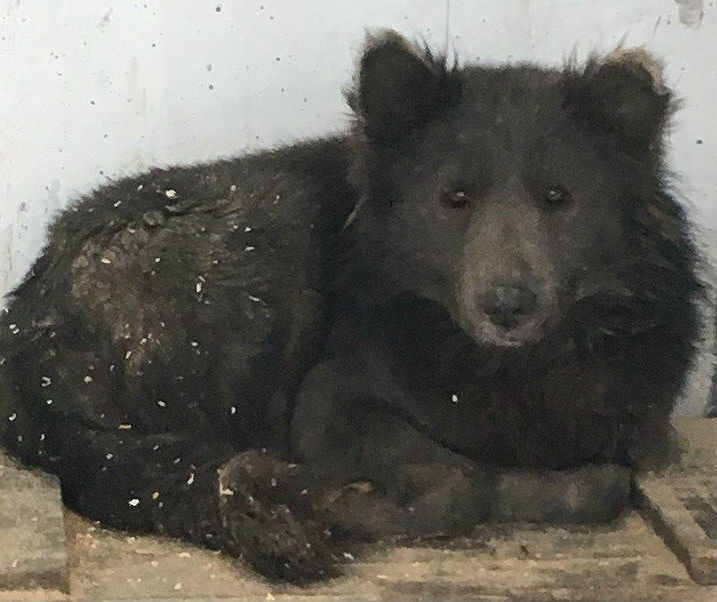
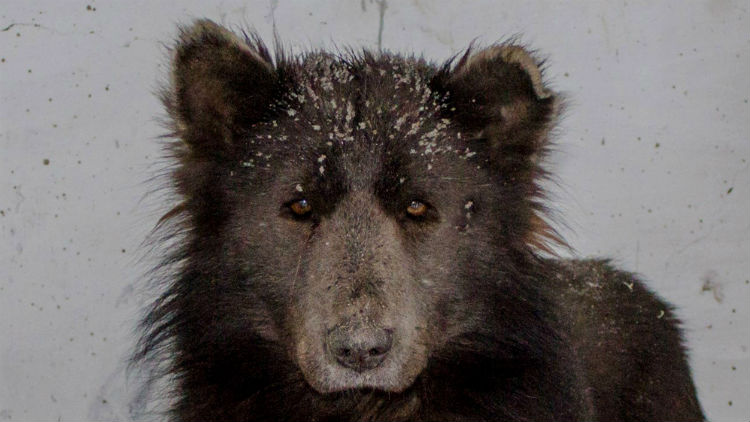
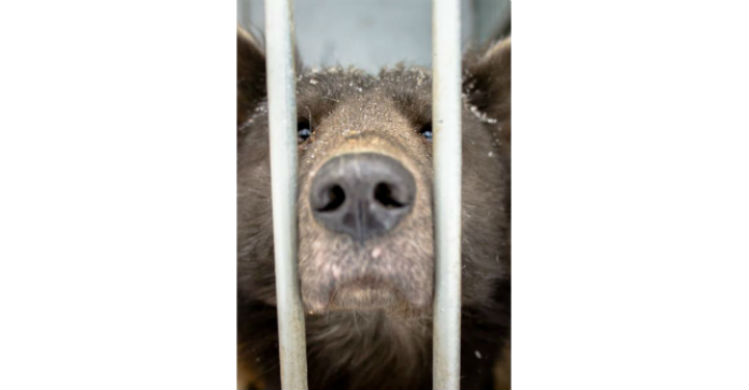
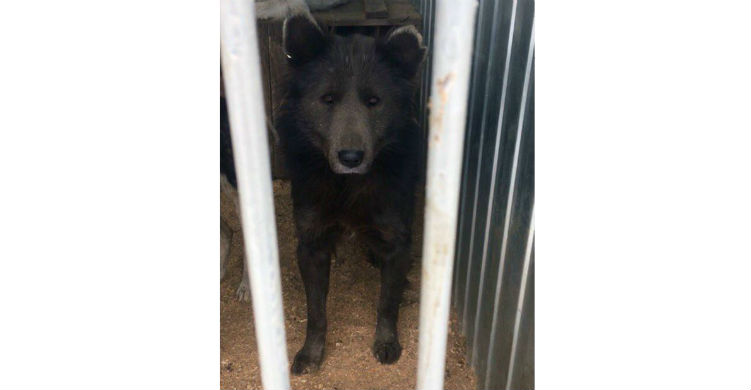
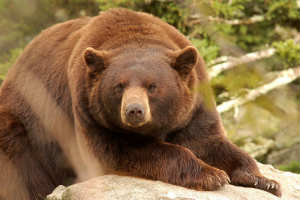 Cinnamon Bear
Cinnamon Bear